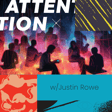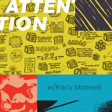Become a Creator today!Start creating today - Share your story with the world!
Start for free
00:00:00
00:00:01

The Audience Growth Flywheel & How to Implement It
In this episode, Dan Sanchez talks abou t the internal framework that Sweet Fish uses to grow the podcast audience's of their customers.
This episode includes:
How to optimize content to increase it's stickiness
Where to advertise your show
How to insure new visitors subscribe and stay
This episode includes:
How to optimize content to increase it's stickiness
Where to advertise your show
How to insure new visitors subscribe and stay
Transcript
Introduction to Building an Audience
00:00:07
Speaker
Welcome back to the Attention podcast. I'm Dan Sanchez with Sweetfish and today I'm going to continue on the thread of where we started off from the last podcast and we're going to steal some more ideas from the startup, specifically the startup marketing world, in order to build an audience for our content marketing.
From Product Market Fit to Media Market Fit
00:00:26
Speaker
Last time we talked specifically about how the product market fit
00:00:30
Speaker
can work with content marketing to become a media market fit so that we can grow our audience by starting lean, starting with the minimum viable piece of media, probably on a short form channel in order to test ideas, to test our hypothesis on what's going to work for our content marketing until we achieve like a media market fit of some kind and it, you know, resonates with people, therefore we can actually execute a whole content marketing strategy with it.
00:00:59
Speaker
And today is
Understanding the Audience Growth Flywheel
00:01:00
Speaker
no different. Today we're going to be talking about what I call the audience growth flywheel. And this is an idea we've been kicking around at Sweetfish for a while, is we've learned how to grow our own podcast and grow the podcast of the many customers that we represent. And naturally, the idea comes from marketing.
00:01:19
Speaker
Everybody's heard of the marketing funnel. And we've all applied the marketing funnel. If you're a marketer, you've applied the marketing funnel somewhere. Even if you disagree with the concept, you've probably thought about it and used it to some degree in your career. And we're all aware of how that conversion funnel works.
00:01:35
Speaker
We got them at the top of the funnel where they're problem aware and then they're solution aware and then they're in the consideration phase and then they convert, right? We all know the steps of the old marketing funnel. It's a very useful tool. I haven't thrown it
Adopting Media Company Strategies for Growth
00:01:50
Speaker
out yet. I still use it when I'm training new marketers and how to think like a marketer and making baby steps for people to become aware and get to know your product and all that stuff until they become a customer.
00:02:00
Speaker
But have you ever considered applying it to your content marketing itself? Now if you want to build an audience, you need to start thinking about subscribing to your channel as the product. And then you can carry over a lot of the same marketing principles to audience growth. So think of becoming a subscriber of your free content as the product you are peddling and build a customer journey
00:02:25
Speaker
all the way down to subscribing and consuming on a regular basis, even becoming an advocate and sharing and think about it as building loyalty for your subscribers.
00:02:38
Speaker
This is what it's like to be thinking like a media company rather than just a marketing department within a company. So we've been championing that idea for over a decade at least about marketing departments need to think more like media departments. And sure, a lot of marketing departments are producing a lot of media, but we're still missing a lot of stuff that traditionally comes with a media company.
00:03:23
Speaker
This
Optimizing Content: The Continuous Improvement Approach
00:03:24
Speaker
sections of the flywheel, the subsections and how it all works together and what we're applying even for our customers on our own shows in order to grow the audience. So the three major parts of the flywheel are currently content optimization, distribution and conversion optimization. So that's a lot of optimization in there. And I feel like it's necessary in order to over explain the mindset you have to have when it comes to building an audience. So let's start with that.
00:03:28
Speaker
is one
00:03:54
Speaker
Building an audience takes time and you can't just do it all at once. You can't optimize and launch and think it's perfect. No, it's actually better to launch rougher and then just take baby steps to becoming better with every single round, with every single piece of content. It's always being optimized. I'm a big fan of the saying, which I believe comes from like the Toyota lean, agile methodology world, always better, never best.
00:04:22
Speaker
always better, never best. With that kind of a mindset, you have the freedom to launch with something that's not half big, but probably not all the way there yet. It's not perfect. It still has a lot to be said for this piece of content you're putting out there.
00:04:40
Speaker
But if you have an always better, never best mindset, each piece can get continually better and better and better. And we all know that's how Toyota dominated the industry decades ago by just making small and tiny improvements on their production lines so that their quality just started destroying the quality of everybody else's cars. And that's why Toyota and Honda soon to adopt their methodologies became some of the leading brands when it came to quality vehicles.
00:05:07
Speaker
was through this always better, never best idea. So I think our content needs to take the same approach into always getting just a little bit better, a little bit better, a little bit better. So that's why I call this first phase of the content or the audience growth flywheel content optimization.
Audience Research and Strategic Content Creation
00:05:25
Speaker
And these are some of the parts of content optimization. A lot of it comes down to research, actually, and just talking to your audience, talking to your customers, talking to people who you think would be the perfect
00:05:38
Speaker
fit for your audience but who haven't actually subscribed yet. Just having conversations with them actively and fairly regularly so that what's on their minds. You should survey them. You should do analysis on those surveys and the conversations you're having so that you can always be adjusting your content to fit what your audience is actually thinking about, wrestling with, what are their wins.
00:06:01
Speaker
What are the measures their boss is using to measure their performance? What's keeping them awake at night? If they can wave a magic wand and make their life better in their careers,
00:06:12
Speaker
What would that look like? These are all the questions you should be asking regularly in order to better understand your customers so that you can just tweak your content ever so slightly on each iteration. And then of course, with all of this research and analysis that you're doing with your target audience all the time, you should be developing some kind of thought leadership. You should be developing points of view that are helpful to that audience.
00:06:39
Speaker
and that's where a lot of your content should come out of the overflow of research and conversation you're having all the time and you think doing analysis and thinking about it strategically, coming up with solutions. And sometimes it doesn't have to be thus safe, you or your company, sometimes it could just be simply asking better questions and then figuring it out with your community or your audience together. This is all part of the content optimization process. It's a lot harder than just having an idea like, oh, we should write a blog about X.
00:07:08
Speaker
and then assign it to a writer, they write it, you publish it, and then share it to social media one time.
00:07:14
Speaker
That's what most people are doing and that's why most audiences don't grow in B2B companies is because we have a hypothesis. We don't test it and we don't go to get feedback from it and then improve our process of creating content with that always better, never best mindset. So that's part one of the audience growth flywheel. You need to be getting feedback and always improving the content regularly, repeatedly, and that process never ends.
Balancing Paid and Organic Content Distribution
00:07:41
Speaker
And we all know that it can't end there, which is why we have part two of this flywheel, which is distribution. A lot of people have written about distribution and I've heard some crazy stuff out there. I hear sometimes, oh, 20% of your time should be making the content, 80% of the time on distribution. I'm like, I don't know. What does that mean? How do we do the distribution? What does that 80% look like?
00:08:03
Speaker
I don't know if I can actually give it a weight of 80% of the time should be in distribution, but you should probably be carving out a significant part for distribution. It's not enough to create good content. Unless you have a flywheel going already, good content will usually just go undiscovered.
00:08:20
Speaker
In fact, if I remember seeing a research report a long time ago saying that how a lot of viral YouTube videos, especially in the early days of videos, went viral. And oftentimes what they found, if you can remember, I remember the one case study in particular was the double rainbow. Remember that YouTube video? And if you don't remember, it's probably because you're under 25 years old.
00:08:43
Speaker
But if you remember the double rainbow video going viral and that with it being just so funny. One thing they discovered was that video had been posted months and months before it actually went viral. It wasn't until one very popular person on Twitter shared it that it kick started it and got an avalanche flowing with that video to go viral. And that's what they found with a lot of these early types of viral videos on YouTube is that they were posted
00:09:08
Speaker
and then they were discovered. And somebody who had an audience shared it, gave it distribution, and bam, it caught like wildfire. That's what we have to do. We have to be able to get your content enough distribution to get this flywheel turning effectively. And there's primarily two different methods of getting the distribution. There's organic and there's paid. Generally, when I'm working with most of my customers, the organic is lacking.
00:09:35
Speaker
Part of the reason why they're trying to build an audience is because they don't have a lot of organic distribution even for their products and so that's a problem, right? So most of the time when it comes to distribution, paid is going to be your best method. Paid is going to be the way you get distribution for your content at first.
00:09:52
Speaker
And if it's going well, you might as well just keep throwing gas on the fire and keep it going faster and faster. If you want to get into organic distribution, of course, social and SEO can play a role in that. And there's a lot to be said about how to do organic distribution through those two channels, and those will be for future episodes. What I want to talk a little bit is how to do paid distribution for your content. As most people are running
00:10:16
Speaker
tens or hundreds of thousands of dollars, sometimes millions of dollars in paid distribution to talk about their product. But they spent hardly anything getting them to subscribe to their organic channels, getting them to build an audience. And that's where the money is. A year ago, I had the privilege of talking to one of the marketers that worked on Morning Brew.
00:10:36
Speaker
And what I discovered is that the morning brew grew naturally through organic growth and through a lot of creative hacks, but it also grew substantially through paid distribution. They had a number of different paid channels. They tested and optimized and found the ones that worked or didn't work to add the most subscribers for the least amount of money, and not just subscribers who subscribed once and unsubscribe, but subscribers who had staying power.
00:11:01
Speaker
And that's one of the key factors of how the morning brew became what it is today. They added paid distribution in order to get that flywheel spinning faster and faster. And once it becomes spinning enough on its own, well now it has momentum and you can start to leverage the power of the audience itself. But at first, to get the traction you need, you have to do
00:11:21
Speaker
paid distribution and my favorite way to do it is to break up the small pieces of content and then promote them with a call to action to subscribe for more or to listen to the longer episode or to watch the full video whatever kind of content you're peddling
Testing and Optimizing Content for Growth
00:11:35
Speaker
break it up into small pieces, pay to distribute it on organic social, organic LinkedIn, or sorry, not organic social, I'm paid social, LinkedIn, Facebook, even paid YouTube, all those work incredibly well. And it depends on which audience and who you're targeting, which one's better, but they all work. And because it's content, generally your cost per acquisition is going to be much lower.
00:12:00
Speaker
bonus points if the content is peddling your thought leadership so you're getting your way of thinking and your subject matter expertise out into the market while also growing your audience. So that's the second part of this flywheel. First, we had content optimization. Second, we had distribution. And the third part is conversion optimization because it's not enough just to throw ads out there. It's not enough just to create good content. You actually have to be watching for all the little conversion metrics in between.
00:12:29
Speaker
You have to be watching the results. You have to be watching the conversion rates on the website as you send people from your content to subscribe to the channel. Are they converting? Are you split testing the page? Are you watching the copy and testing out different things, different endorsements, different previewing, different types of content before they hit the subscribe button.
00:12:49
Speaker
and that could be subscribed by email, it could be subscribed by YouTube, and there's limitations in different places, but are you optimizing what you can? Are you measuring what you can? There's a CRO or a conversion rate optimization mindset that you need to be applying in order to grow your audience.
00:13:04
Speaker
Believe it or not, if you look at MrBeast as silly as some of his videos are, the man spends a lot of time thinking about conversion rate optimization, which is why he spends a lot of time and attention split testing his thumbnails as soon as a new video goes live. He split tests it to figure out which one does the best.
00:13:24
Speaker
in order to drive the growth of a video. So it's a mindset we need to also have when it comes to growing our own audiences and growing our email list and growing our social channels. Are we experimenting? Are we trying out different things? Are we taking different hypotheses that we formed while doing the research and the content optimization and then testing them out as we run our ads, as we send people to landing pages, as we try out different content mixes, as we try out different thumbnails.
00:13:53
Speaker
So you have to have that going on as well. And that is the third
The Synergy of the Audience Growth Flywheel
00:13:58
Speaker
stage. When you do conversion optimization, you learn and grow because every test exposes a learning.
00:14:07
Speaker
which then swings back into effect in your content optimism. And that's where it becomes the flywheel, because all of this works and spins together. And the better you get at all three, the more the flywheel spins round and round. So that's the lesson. That's what we are doing at Sweetfish in order to grow our podcast audiences and the audiences of our customers. And I'm hoping to unpack that even more in future episodes. But that's the audience growth flywheel.
00:14:34
Speaker
Thanks for listening. Since you've made it this far, I'd like to ask if you could please leave a rating for this show. It's new and every single time someone taps the star rating button, it helps a ton. So if I could ask for one thing from you, leave a rating. Thank you.
















